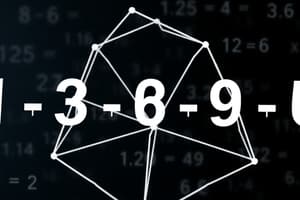Podcast
Questions and Answers
Which of the following best describes the primary purpose of mathematics?
Which of the following best describes the primary purpose of mathematics?
- To memorize formulas and equations.
- To create artistic designs.
- To understand and model the world. (correct)
- To develop new computer games.
Which set of numbers includes both positive and negative whole numbers, as well as zero?
Which set of numbers includes both positive and negative whole numbers, as well as zero?
- Whole numbers
- Rational numbers
- Natural numbers
- Integers (correct)
Which of the following is an example of an irrational number?
Which of the following is an example of an irrational number?
- $ rac{1}{2}$
- -5
- $\sqrt{2}$ (correct)
- $3.14$
What is the next operation after evaluating the exponents, according to the order of operations (PEMDAS/BODMAS)?
What is the next operation after evaluating the exponents, according to the order of operations (PEMDAS/BODMAS)?
What is the purpose of using variables in algebra?
What is the purpose of using variables in algebra?
Flashcards
What is Mathematics?
What is Mathematics?
A branch of science that deals with numbers, quantities, and shapes. It includes areas like arithmetic, algebra, geometry, calculus, and statistics.
What are Rational Numbers?
What are Rational Numbers?
Numbers that can be expressed as a fraction p/q, where p and q are integers and q is not zero.
What are Irrational Numbers?
What are Irrational Numbers?
Numbers that cannot be expressed as a fraction of two integers.
Study Notes
Fundamental Concepts
- Mathematics is a branch of science that deals with numbers, quantities, and shapes.
- It encompasses various fields, including arithmetic, algebra, geometry, calculus, and statistics.
- Mathematics provides a framework for understanding and modeling the world around us.
- It involves logical reasoning, problem-solving, and pattern recognition.
- Mathematical concepts are fundamental to many other disciplines, like physics, engineering, and computer science.
Number Systems
- Natural numbers (counting numbers): 1, 2, 3,...
- Whole numbers: 0, 1, 2, 3,...
- Integers:..., -3, -2, -1, 0, 1, 2, 3,...
- Rational numbers: numbers that can be expressed as a fraction p/q, where p and q are integers and q ≠ 0.
- Irrational numbers: numbers that cannot be expressed as a fraction of two integers. Examples include √2 and π.
- Real numbers: the set of all rational and irrational numbers.
- Imaginary numbers: numbers involving the square root of -1 (represented by 'i').
- Complex numbers: numbers that can be expressed in the form a + bi, where a and b are real numbers.
Arithmetic Operations
- Addition (+): combining two or more numbers to find a sum.
- Subtraction (-): finding the difference between two numbers.
- Multiplication (× or ⋅): repeated addition of a number.
- Division (÷ or /): splitting a number into equal parts.
- Order of operations (PEMDAS/BODMAS): a set of rules for evaluating expressions involving multiple operations in a specific sequence (Parentheses/Brackets, Exponents/Orders, Multiplication and Division, Addition and Subtraction).
Algebra
- Variables: symbols (like x, y, z) representing unknown values.
- Equations: statements showing the equality of two expressions.
- Inequalities: statements showing the relationship between two expressions (e.g., >, <, ≥, ≤).
Studying That Suits You
Use AI to generate personalized quizzes and flashcards to suit your learning preferences.




